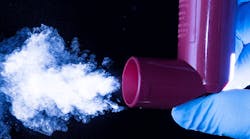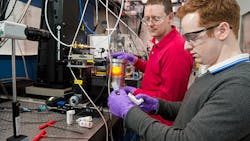Researchers at Argonne National Laboratory, Lemont, Ill., are taking the expertise they’ve acquired studying automotive fuel injectors and applying it to medical inhalers such as those used by asthma sufferers. The goal is to identify factors that determine an inhaler’s effectiveness and then use that knowledge to develop inhalers that can deliver drugs currently given to patients as gels or injections or in small doses.
In conventional inhalers, the drug gets mixed with a cosolvent and liquid propellant while suspended in a small chamber inside the inhaler’s canister. When the patient squeezes the canister, activating it, the chamber opens to the outside, the propellant flash boils, and the pressure created shoots a precisely controlled volume of the mixture out of the chamber through a nozzle and into the patient’s mouth. As the spray expands, the cosolvent evaporates, until only droplets of medicine remain suspended in air as it moves through the trachea and into the lungs.
The biomedical challenge is to ensure those droplets are the right size and in the right distribution. Too small, and the droplets hang in the air, milling around in the lungs until being exhaled without settling on the surface of the alveoli (air sacs) or delivering the medication. Too large, and droplets don’t remain suspended in air long enough to make it deep into the lungs, instead coating the mouth and trachea where the drug is not effectively absorbed.
Standard imaging techniques would only let researchers see inside the spray when it is inches from the nozzle and already dispersed enough to be translucent. But images and data at this stage only reveal the results of the spray and little about the process that created it. All the important action—the phase changes and complex thermodynamic effects--take place inside the nozzle and in the first few millimeters of the spray, where the spray is too dense to see inside of it.
To get around this hurdle, the research team peered inside the spray using X-rays from the world’s only dedicated fuel-injection beamline at the Advanced Photon Source, an Energy Dept. facility. These intense X-rays could penetrate the dense sprays and provide unprecedented details on how the spray changes over time. The researchers gained even more information by looking at sprays of a drug that fluoresces in the presence of X-rays. This let them measure the drug’s dispersion in the spray.
The team gathered data which showed that predictions based on standard thermodynamic models of what should be going on inside the spray did not always correlate to their observations. For example, thermodynamics seem to say that sprays should behave the same way during every use. But there was more variability than expected in the spray’s turbulent structure. Researchers also discovered that sprays were less dense than had been previously predicted.
The team’s findings could lead to better-designed inhalers for drugs that require precise and repeatable dosages, such as insulin for diabetics. A new generation of inhalers could also mean more accurate delivery of drugs to patients with impaired lungs due to disease or aging.

